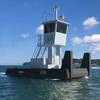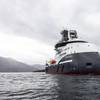By Don Sutherland
Everyone knows everyone else's business in this industry, or at least they think they do, and certainly try to. Who owns this or is buying that is information as eagerly sought for tactical insight as it is for gossip, and is equally protected by those in the know.
The ex-S/R Everett, lately known as the Lincoln Sea, has been a buzz on New York harbor ever since the newswires hummed with reports that K-Sea had bought the Mobil-built boat. But that was back in January. If it's true, the scuttlebutt asked, how come the winter has passed, the spring has passed, and the boat's still painted blue - not the white superstructure, green decks, tan stacks, and red trim of K-Sea?
For our part, MarineNews probably contributed to the enigma with our "New York's New Faces" roundup in the Yearbook edition (June 2004).
That article depicted many new arrivals on these waters, including two - the Tasman Sea and the Volunteer - that were recent additions to the K-Sea fleet. But not a word about Lincoln Sea. If an authoritative, know-it-all periodical like ours doesn't mention it, some people might think, it must not exist.
But the Lincoln Sea did exist, as anyone passing the Bay Ridge anchorage, or traveling between the Big Apple and Albany could see. What gives? Except for her robins-egg coloration, she might have been mistaken for the new ATBs of Reinauer, such as the Merideth, whose picture we printed. But Lincoln Sea didn't appear in the article. What did that mean?
It meant that K-Sea's Tom Sullivan had asked if we'd mind holding the photos, till the boat was in proper colors? We're easy at MarineNews. We said sure, we'll hold the photos, just as long as we get to ride the boat when she's ready.
A Long Ride
As the Everett, the boat had sat idle for more than a year, a condition that never contributes to general good looks. Every mariner knows that even the best-kept boats develop rust here and there - salt water does that to steel - and we all forgive the occasional patch on a deck or a wall. But nowadays, there are others besides mariners who admire K-Sea's fleet.
The company went public not long ago, and not every investor necessarily knows that brown spots are the norm upon working vessels.
K-Sea can rightly boast of some of the cleanest craft in New York, but you wouldn't have known it from the Lincoln when they first put her in service.
And she went into service at once. Part of her $34-million purchase from EXXON/Mobil included a multi-year contract to deliver product to the EXXON/Mobil terminal in Albany. No time to stop to haul the boat and paint her all pretty.
But cleaning and painting did proceed as opportunities arose dockside, between the two to three weekly runs Lincoln Sea typically makes. About twelve hours up, about twelve hours down, about twelve hours in between for unloading, the boat and its matched barge, ex-Seneca, now DBL 140, were nearly perpetual-motion machines and familiar sights - a new fixture - on the Hudson. Still, one day people looked up and, by gosh, the Lincoln's stacks were suddenly tan.
Bit by bit, the boat started sprucing-up. Finally, by July, she looked like a proper K-Sea boat. There still hadn't been time for a drydock, but at least to the waterline she was bright and sparkling.
A 500-foot-long petroleum barge can take even longer to paint. The double-hulled DBL 140, with its 140,000 BBL capacity, is scheduled for the yard at the end of the year. We're sure we'll be able to comb our hair in the reflection when she comes out.
The Lincoln Sea was gussied-up enough by the week of Hurricane Charley that Kodak Moments were deemed feasible. "We're way overpowered for this run," commented Capt. Bob Cunha as we steered north. "We can easily do 11 knots with the barge fully loaded," with twin EMD 16-710G7Bs delivering 8000HP at 900 RPM. "This unit was made for the ocean - but the contract specified the Albany run, so here we are. With a vessel this size, I have to slow-down to a crawl whenever we pass marinas, beaches, environmentally sensitive areas - at full speed, we'd suck the boats right off the shore." Maybe Newburgh or Kingston, too.
We arrived at the Albany terminal on schedule, but the terminal wasn't ready to receive the load. Two more days would pass before unloading could commence, during which the crew was confined to the vessel in compliance with the terminal's security policy (MARSEC 1 at the time). The guy from MarineNews was similarly confined, giving us plenty of time to get to know Lincoln Sea.
All the Bells and Whistles
Coast Guard regulations still require a bell aboard a boat, to serve for alarm or communications during, say, a fog. More modern methods have pretty much displaced this bell, and high atop the Lincoln Sea, its ding would probably be inaudible over another boat's motors. But for the record, it is there - the first of the bells in the many bells and whistles aboard this de luxe tugboat.
The Lincoln's Chief, Donnie Nixon, said he'd toured the boat's near-sisters, similarly designed by Ocean Barge and Engineering.
But automation, redundancy and back-up, and general comfort were far more extensive on the Lincoln, he reported. This newest pride of the K-Sea fleet, SOLAS-class, shows thoughtfulness and thoroughness that old-timers in the oil-transport business say typified Mobil builds. With its appointments and comforts, there's plenty aboard that you wouldn't have found on your father's tugboat.
Most of all, the Lincoln is spacious. Passageways are broad, their floors covered in a resilient material that gives great traction, and is far more comfortable underfoot than steel.
The L-shaped galley is fully-equipped down to a blender, with toaster and microwave ovens besides the conventional convection oven. Two upright freezers stand beside two equally massive upright refrigerators back toward the stores section of the room, while a smaller fridge built into a counter keeps chilled water and sodas at arm's length from the galley table.
Betty Furness would have approved. `Deckhand Chris Beath in this very galley whipped-up a fish chowder that someone should write songs about.
Because so much of a purpose-built ITB involves a tower, four decks high in this case, a lot of the items that clutter and crowd a tug can be deployed vertically. The air-conditioning system, for example, inhabits the deck below the wheelhouse. Alongside it, someone installed a desk and computer.
Such amenities are good for morale, and there's no need retelling how that's good for the boat. But some of the touches are good as well for safety. Take the stairs.
Tugboaters are accustomed to steel ladders, plumb vertical or slightly canted and thinly disguised as stairs. They're not places you want to traverse quickly, though given the nature of tugboating, you're sometimes obliged to.
We don't know if the actuaries would agree, but of all the injuries we've heard of at sea, the largest number involved trying to climb up or down.
The stairs on the Lincoln, by comparison, are just that - stairs, set into staircases of a reasonable length and angle, featuring treads large enough for even a size-12 foot to fit comfortably.
If you had to go up or down these steps quite swiftly, you could probably do so and still own two ankles.
The wheelhouse itself with its sweeping curved perimeter, richly paneled, has a look that used to be called futuristic. It's just state-of-the-art now, with monitors of varying sizes showing where in the world you are, and what's going on everywhere aboard.
EMS Marcon's labels adorn many appliances around the boat. Steadfast and resolute amid it all, a good old-fashioned compass with its old-fashioned magnets kept an optical eye on things. There are backups to many backups aboard the Lincoln sea. The Chief can run the boat, if required, from a couple positions belowdecks.
One of the touchscreen panels in the wheelhouse controls the pins of the boat's Intercon locking system. This is the first K-Sea boat thus equipped, the JAK system having been picked for their several recent pinboat conversions.
The gents aboard who've worked with both systems seem to agree that each has its points, though greatly different ones.
One may be easier to hook-up to, let's say, where another's easier to live with underway. The Intercon system involves a massive array of machinery below, 130,000 pounds' worth in the case of the Lincoln Sea. You would not want to drop any of its parts on your foot.
Someone mentioned that the JAK system has gotten K-Sea units back and forth three times from Pakistan, carrying liquid foodstuffs. That probably says something about seaworthiness. But a self-greasing system like Intercon's says something about life at sea, too. As far as these gents knew, both systems have their points and both get their job done, and that's all they want to know about.
What's in an Acronym
Ask any mariner what language we speak, he'll tell you American. But that's only half a word, at least during working hours. That's when the lingo becomes American Marine. In this quaint tongue you can describe how to "make up to the barge," without seeming to mean you're apologizing to it. The fact that everyone nearby understands you makes your dialectic jargon seem like the King's English. But it's not. Not only is it a secret language, it's regional as well - even in the age of telecommunication.
No one, for example, outside certain Great Lakes regions seems to know what a "fish tug" is, and even some people who've been on the Lakes don't. "I worked on the Lakes for years," Capt. Cunha told us, "I never heard the term 'fish tug.'"
Pronunciations vary too, depending where. Take the old song, "Eddystone Light," as sung years back by Burl Ives. According to one line, "A voice from the starboard shouted 'ahoy,'/ And there was my mother a-sitting on a buoy."
But pronunciations being what they are, in the Northeast at least, the song would have to go, "A voice from the starboard shouted 'hey, Louie,'/And there was my mother a-sitting on a buoy." It could be easy for a new mate to wonder what an old skipper was talking about.
In some maritime locales, a part of the tow gear is called a pendant, in other locales, a pennant. The former's more descriptive - the rig hangs like a jeweled pendant from milady's neck - the latter, though describing a type of flag, is easier to say. There are usually good reasons why things are called what they are, but there also may be different good reasons.
Which brings up a question: when is an ATB an ITB?
Answer: An ATB is an ITB when K-Sea takes possession of the ex-S/R Everett.
The definition of both is sometimes thought settled, though nevertheless still sparks debates. The Lincoln Sea crew, in calls, say, to Traffic, routinely describes themselves as "the ATB Lincoln Sea." Yet she's officially an ITB - that is, the Coast Guard calls her an "Integrated Tug and Barge, Dual-Mode." The original-style ITBs are "Integrated Tug and Barge, Single-Mode."
K-Sea has always called their units dual-mode ITBs.
The original ITBs were rigid, composed more literally as an engineroom that could separate from a tanker. Once apart, the self-propelled stern section served little use as a "tug." The ATB came up a bit later, an alternative, an improvement, signifying an aft section which, disconnected from the tanker, could go out as a fully functional tugboat, winches and towing machines and all.
Less rigidly connected in the notch, it must have seemed fair to call her articulated, and it must have seemed wise - the rigid ITBs turned out to be a bit awkward.
K-Sea's other pinboats are regular tugs that can do all sorts of tuglike things. They have large foredecks where hands have space to work, and lots of machines on deck aft.
The Lincoln Sea's foredeck is foreshortened, and only a capstan - not even a Texas bar - occupies the fantail. She's theoretically capable of tugboatlike chores out of the notch, but in practicality, not many.
She certainly wouldn't dock many ships, and is sparsely equipped for towing. She was built to live deep in the notch - that is to say, to be integrated with the barge.
Does Webster's change the language, or does the language change Webster's? Actually, both, in no predictable pattern. We'll see what they're calling matched, mated tug-and-barge systems in twenty years.
For now, the dual-mode system is generally considered to be "the future" of long-distance bulk liquid transport. And with the mighty, the impressive, the majestic Lincoln Sea, K-Sea seems to have increased its grasp on that future.
Featured videos

Inmarsat Enhances Service to Drive Digitalization

Inside the Electrified Truckable Tug

Tracking Foreign Vessels Working in the U.S. Jones Act Market
Subscribe for
Maritime Reporter E-News
Maritime Reporter E-News is the maritime industry's largest circulation and most authoritative ENews Service, delivered to your Email five times per week









